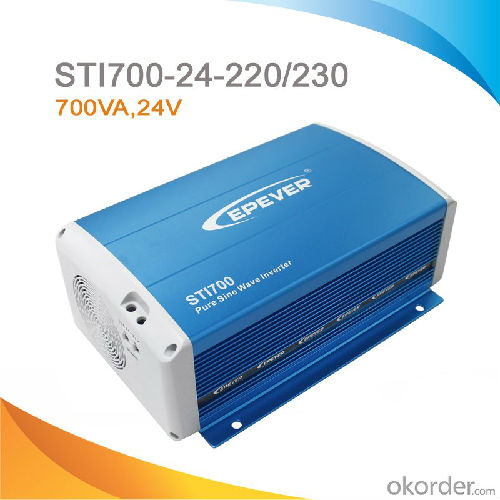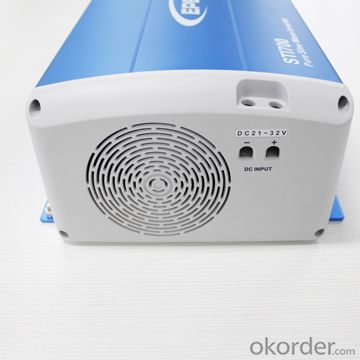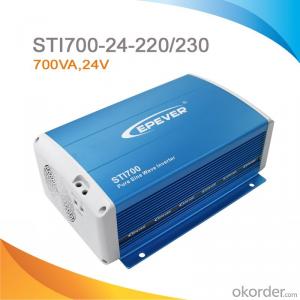High Efficiency Off-Grid Pure Sine Wave Power Inverter 700W, 24V-220V/230V,STI700
- Loading Port:
- China Main Port
- Payment Terms:
- TT or LC
- Min Order Qty:
- -
- Supply Capability:
- -
OKorder Service Pledge
OKorder Financial Service
You Might Also Like
Description
STI series is a sine wave power frequency inverter which can convert 12V or 24V DC to 220VAC or 230VAC 50Hz based on full digital and intelligent design. The inverter can be applied in many fields especially for solar photovoltaic power system.


Features:
·Complete isolation-type inverter technology, noiseless output
·Adoption of advanced SPWM technology, pure sine wave output
·Dynamic current loop control technology to ensure inverter reliable operation.
·Wide DC input voltage range
·Excellent EMC design
·Low output harmonic distortion(THD≤3%)
·LED indicators display input voltage range, load power range, normal output & failure state
·Optional energy saving mode
·Wide working temperature range (industrial level)
·Continuous operation at full power
Protections:
·Output Short Circuit protection
·Overload protection
·Input reverse polarity protection
·Input low voltage protection
·Input over voltage protection
·Inverter abnormal protection
·Overheating protection


Specification:
Types | SHI600-12 | SHI600-22 |
Nominal Battery Voltage | 12V | 24V |
Input Voltage Range | 10.8~16Vdc | 21.6~32Vdc |
No Load Current | ≤0.7A | ≤0.45A |
Output Wave | Pure Sine Wave | |
Output Voltage | 220Vac±3% / 230Vac±10% | |
Continuous Power | 600W | |
Power 10 sec | 900W | |
Power 1.5 sec | 1200W | |
Surge Power | 1350W | |
Frequency | 50/60Hz±0.2% | |
Distortion THD | ≤ 3% (resistive load) | |
Efficiency at Rated Power | ≥91% | ≥92% |
Max. Efficiency | ≥93% | ≥94% |
Terminal | 25mm2 | |
Dimensions | 295×186×82mm | |
Installation | 150×178mm | |
Hole Size | Φ6mm | |
Net Weight | 2.3kg | |
Working Temperature | -20℃~ +50℃ | |
Storage Temperature | -35℃~ +70℃ | |
Humidity | < 95% (N.C.) | |
Altitude | < 5000m(Derating to operate according to IEC62040 at a height exceeding 1000m) | |
Insulation Resistance | Between DC input terminals and metal case: ≥550MΩ; Between AC output terminals and metal case: ≥550MΩ. | |
FAQ
Off Grid VS On Grid Panels, what's the difference?
The differences between both panels are related to the system where they are going to be installed.
On-grid installations, as the name said, are thought to feed the produced energy into the grid and for that it is important to have the biggest voltage that it is allowed (1000VDC in Europe, 600 VDC in USA). For a defined power, more voltage means less current (P=V*I) and less losses.
In off-grid installations it is different because you must storage the energy into batteries. Batteries usually work at 12, 24 or 48 VDC and off-grid photovoltaic modules work at the maximum power point (mpp) near this voltage (see the datasheets). So the controller that charges the batteries works also near the batteries voltage.
Your limiting factor here is going to be this controller. You have to see what is the maximum voltage and the maximum current that it can work with, upstream (photovoltaic modules) and downstream (batteries andinverter). Then you have to dimension your PV array (Voltage and Current).
Does inverter long warranty mean high quality?
SMA did bump up the warranty to 10 years when CSI demanded all inverter manufacturers to do so. The European Sunny Boys are only warrantied for 5 years.
iPhones only have a one year warranty. Does that mean Apple products aren't reliable? Enphase offers a 25 year warranty on theiribut only one year on their inverters monitoring. Does this mean their monitoring is not as reliable as their inverter? Of course not.
Offering long warranties have very real costs, especially for publicly traded companies like SMA. If we were to offer a 25 year warranty, we would have to hold a higher reserve on our balance sheet, making our products more expensive. We think that our customers would rather have our high quality products at a lower cost.
Start-ups invariably offer long warranties to make up for lack of track record or the perception of quality problems. As the unfortunate recent events at Solyndra have shown, long warranties offered by start-ups can have limited practical value.
Analogies can be drawn to the wind industry: in the early days, customers requested very long warranties (20 years or so), since it was the wild west and no one had a clue about long term O&M requirements for these big new turbines. Now that the wind industry has matured, turbine warranties are again very short (2 years is typical) since the large suppliers have a track record of shipping quality product that does not fail when properly maintained. You could say that PV today is like the wild west environment in wind 10 years ago.
- Q:Can a solar inverter be used in systems with different module strings?
- Yes, a solar inverter can be used in systems with different module strings. Solar inverters are designed to be compatible with a wide range of module string configurations, allowing for flexibility in system design and installation. The inverter's maximum input voltage and power ratings should be considered to ensure compatibility with the different module strings, but as long as these specifications are within the inverter's limits, it can effectively convert the DC power generated by the module strings into AC power for use in the system.
- Q:What is the function of a solar inverter in a solar power system?
- The function of a solar inverter in a solar power system is to convert the direct current (DC) produced by the solar panels into alternating current (AC), which is the type of electricity used in most homes and businesses. This allows the solar energy to be utilized for powering electrical appliances, feeding excess energy back into the grid, or storing it in batteries for later use.
- Q:What are the key factors affecting the cost of a solar inverter?
- The key factors affecting the cost of a solar inverter include its power capacity, efficiency, technology type, brand reputation, warranty, additional features, and installation requirements.
- Q:Can a solar inverter be used for residential applications?
- Yes, a solar inverter can be used for residential applications. A solar inverter is an essential component of a residential solar energy system as it converts the direct current (DC) generated by solar panels into usable alternating current (AC) electricity that can power household appliances and be fed back into the grid.
- Q:What is the PV inverter starting voltage
- Inverter is a kind of semiconductor device composed of power adjustment device, mainly used for DC power into AC power. Generally consists of boost circuit and inverter bridge circuit. The boost circuit boosts the DC voltage of the solar cell to the DC voltage required for the inverter output control. The inverter bridge circuit converts the boosted DC voltage to the AC voltage of the common frequency. The inverter is mainly composed of a switching element such as a transistor, and turns the DC input into an AC output by repeatedly turning ON-OFF the switching element in a regular manner. Of course, it is not practical to simply output the inverter output waveforms from the on and off circuits
- Q:Can a solar inverter be used with a wireless communication system?
- Yes, a solar inverter can be used with a wireless communication system. In fact, many modern solar inverters are designed with built-in wireless communication capabilities to allow for monitoring and control of the system remotely. This enables users to access real-time data, adjust settings, and receive notifications about the performance of their solar power system through a wireless connection, such as Wi-Fi or cellular networks.
- Q:Can a solar inverter be used in a net metering system?
- Yes, a solar inverter can be used in a net metering system. A solar inverter is an essential component of a solar energy system, as it converts the direct current (DC) electricity generated by solar panels into alternating current (AC) electricity that can be used to power homes and businesses. In a net metering system, excess electricity generated by the solar panels is fed back into the grid, and a solar inverter facilitates this process by synchronizing the electricity produced with the utility grid.
- Q:Can a solar inverter be used in a ground-mounted solar tracking system?
- Yes, a solar inverter can be used in a ground-mounted solar tracking system. In fact, the solar inverter is an essential component of the system as it converts the DC electricity generated by the solar panels into AC electricity that can be used to power appliances and be fed into the grid. The solar inverter's functionality remains the same whether it is used in a ground-mounted solar tracking system or a fixed tilt system.
- Q:What are the potential risks of fire or explosions from a faulty solar inverter?
- The potential risks of fire or explosions from a faulty solar inverter include short circuits, electrical arcing, overheating, and component failure. These issues can lead to an accumulation of heat, sparks, or electrical discharges, which may ignite flammable materials nearby or cause an explosion. It is crucial to regularly inspect and maintain solar inverters to mitigate these risks and ensure the safe operation of the system.
- Q:What is the power factor correction capability of a solar inverter?
- The power factor correction capability of a solar inverter refers to its ability to adjust the power factor of the electricity it produces. A power factor is a ratio that measures the efficiency of electrical power usage, with a value between 0 and 1. A solar inverter with good power factor correction capability can optimize the power factor towards unity (1), which indicates maximum efficiency. This helps in minimizing reactive power and reducing energy wastage, resulting in a more efficient and effective utilization of solar power.
1. Manufacturer Overview |
|
|---|---|
| Location | |
| Year Established | |
| Annual Output Value | |
| Main Markets | |
| Company Certifications | |
2. Manufacturer Certificates |
|
|---|---|
| a) Certification Name | |
| Range | |
| Reference | |
| Validity Period | |
3. Manufacturer Capability |
|
|---|---|
| a)Trade Capacity | |
| Nearest Port | |
| Export Percentage | |
| No.of Employees in Trade Department | |
| Language Spoken: | |
| b)Factory Information | |
| Factory Size: | |
| No. of Production Lines | |
| Contract Manufacturing | |
| Product Price Range | |
Send your message to us
High Efficiency Off-Grid Pure Sine Wave Power Inverter 700W, 24V-220V/230V,STI700
- Loading Port:
- China Main Port
- Payment Terms:
- TT or LC
- Min Order Qty:
- -
- Supply Capability:
- -
OKorder Service Pledge
OKorder Financial Service
Similar products
New products
Hot products
Hot Searches
Related keywords





























